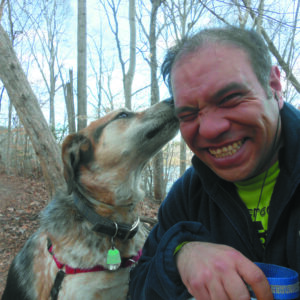If you are of a certain age, you’ll remember commercials that ran on television proclaiming that people “don’t have time for a yeast infection.” Humans certainly don’t, but did you know that yeast infection in dogs happens, too? It may be even more surprising, if not shocking, to learn that the microorganism responsible for things like fungal ear infections are living happily on your dog right now!
There is no immediate cause for panic; this fungus also makes a home on your body as well. The single-celled creature we speak of is a yeast called Malassezia pachydermatis. Like the Demodex canis mites that can cause mange in dogs, yeast is a commensal organism. This means that, under normal circumstances, it lives and thrives on the outside of a dog’s body, but does the host neither benefit nor harm.
When conditions are auspicious, however, something upsets the typical balance, and the fungus seizes the chance to reproduce unchecked. This population explosion leads harmless microorganisms to become opportunistic pathogens, which then leads to a yeast infection in dogs. Let’s learn more about yeast infection in dogs.
Causes of yeast infection in dogs

The Malassezia pachydermatis fungus is just one among many microorganisms that call your dog home, so what keeps them from running riot? A healthy dog’s immune system is quite good at regulating all of its microflora. Beginning with antibodies drawn from the mother during nursing, strengthened by vaccinations, and bolstered by regular interactions with their environment, the body welcomes and begins adjusting to all manner of tiny creatures from the moment a puppy is born.
This unicellular yeast is like any other fungus, which means it needs the right conditions to live and reproduce. What are these conditions? It’s actually very simple: fungi need heat. The proper temperature for Malassezia pachydermatis is in the range of 86 to 99 degrees F on-site. For this reason, the yeast tends to reside in the warmer corners and crevices of your dog’s body, around the ear canal, and between the toes.
Agents that cause yeast infection in dogs
Because of their need of heat, a yeast infection in dogs is more likely to occur in the late spring through summer and early fall, periods of high humidity. The temperature, outdoors or in, makes a difference, but it is not the only cause of uncontrolled yeast growth. Any agent that prevents proper ventilation of the skin or ears — even the ears themselves — can bring about a canine fungal infection. These agents include:
1. Water
A dog who spends a lot of time in and around water, for instance, and doesn’t dry out or shake it off sufficiently. It doesn’t have to be beastly hot for the warmth already subsisting between the toes on your dog’s feet or inside the ear canal to create the right conditions for fungi to grow and multiply.
2. Ears
Dogs with long and floppy ears, those with ear canals that are poorly ventilated due to coat length, or those with unchecked growth of hair inside the canal are at special risk for fungal ear infections. Fungal infections of the ear are perhaps the most common yeast-based afflictions among dogs.
3. Oil and wax
These are natural oils found on the skin and excessive wax buildup in the ear canals. A dog who is improperly or erratically groomed can experience buildup of skin oils, which traps available heat and allows the yeast to create more yeast through asexual budding. The same goes for ear wax.
We’re really only looking here at how these infections get going in typically healthy dogs. Immuno-compromised dogs or puppies are at greater risk, as are dogs suffering from other bacterial illnesses. Additional circumstances that may allow yeast to flourish are allergies to food or fleas, as well as long-term use of certain steroid medications, like prednisone.
Symptoms of yeast infection in dogs
Fungal infections happen when mundane microbes take advantage of circumstances, turning into opportunistic pathogens that cause health problems. Opportunities can arise anywhere and anytime the fungi are present; in other words, tiny, short-haired dogs who live in Alaska might be a bit safer from yeast infections in dogs than long-haired, floppy eared dogs in Florida, but not much.
The primary focus here is a condition known as otitis externa, or what, in humans, we call “swimmer’s ear.” Symptoms of canine otitis include dogs holding their heads at awkward or unusual angles, or pawing insistently at one ear. As the condition advances and the yeast reproduces, you’ll start smelling a strange odor and seeing crust forming around the outer ear canal, accompanied by discolored ooze and, later, even blood.
Malassezia pachydermatis can also cause skin infections in dogs, a condition known as yeast dermatitis. The first sign you may notice includes flaky, dry skin. Look for a dog scratching at a specific site, under their arms, for instance, or rubbing at a certain spot on the nose. They may be chewing or biting at skin that has become darker or redder. The most blatant symptom, “elephant skin,” will appear in more advanced cases. Left untreated, this fungal skin infection can lead to secondary bacterial infections.
How to get rid of a yeast infection in dogs
The earlier a veterinarian diagnoses a yeast infection in dogs — skin or ear — the simpler the process of treatment will be. If it is caught soon enough, topical antifungal salves, such as miconazole, can be applied after any excess hair at the site of infection is trimmed and the area is properly cleaned. If the problem is advanced, or if the infection has penetrated further, the vet might prescribe a more intense antifungal medicine, fluconazole, administered in tablet form.
As a fungal ear infection worsens and otitis externa gives way to otitis media, or even otitis interna — the latter being all the way down the ear canal — fluids begin to gather inside the ear canal, whose exit point can swell shut. Worst-case scenario, or at least worst-case excepting deafness, is a surgical procedure called total ear canal ablation, or TECA.
For external issues like yeast dermatitis, special antifungal shampoo can be used to relieve your dog’s symptoms. How long and how often the dog will need bathing depends on the yeast infection.
Preventing yeast infection in dogs
When it comes to yeast infection in dogs, prevention is always the simplest route to take.
If your dog is at higher risk for yeast infection in dogs — one with floppy ears or with hair sprouting from inside the ear — the easiest things to do are to dry them thoroughly after water adventures or baths and keep excess hair trimmed. A dog’s immune system should be strong enough to restore balance with native microbes, but a little help on your end never hurts.
Read more about dog health and care on Dogster.com:
- Frito Feet — Here’s Why Your Dog’s Paws Smell Like a Popular Corn Chip
- Hypothermia in Dogs: Symptoms, Treatment and How to Prevent It
- Do Dogs Have Belly Buttons?
Featured Image Credit: HAYKIRDI | E+ / Getty Images Plus.






